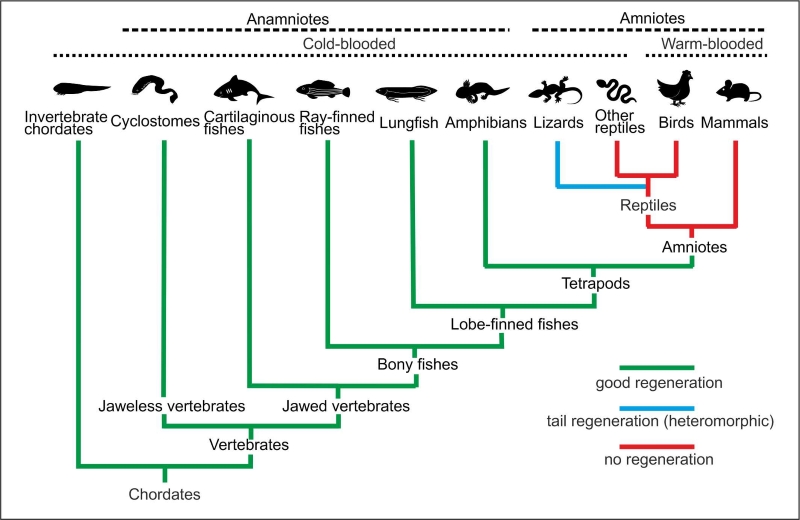Press-room / news / Science news /
Loss of Ability to regenerate Limbs in Higher Vertebrates: From Side Effects of Evolutionary Innovations to Gene Loss
Researchers from the Laboratory of Molecular Foundations of Embryogenesis at the GNC IBCh RAS have identified the main factors that rendered limb regeneration impossible in modern amniotes (reptiles, birds, and mammals). The authors suggested that after the ancestors of amniotes transitioned to land, their ability to regenerate limbs was suppressed by the side effects of various innovations that emerged at that time, which were necessary for successful colonization of land. This, in turn, stimulated the disappearance of many genes that ceased to participate in regeneration from that moment on. As a result, in modern amniotes, including humans, the inability to regenerate limbs became firmly fixed at the genomic level.

The ability to regenerate large body appendages (limbs and tail) is an inherited trait in vertebrates that varies among different groups of animals. While anamniotes (fish and amphibians) typically possess this ability, it is significantly limited in amniotes (reptiles, birds, and mammals). In this review, we examined the factors contributing to the loss of regenerative abilities in amniotes. Firstly, we analyzed the potential negative impact on appendage regeneration of four evolutionary innovations: developed adaptive immunity, keratinization of the skin, endothermy, and increased body size. These innovations emerged during the transition of amniotes from aquatic to terrestrial environments and were correlated with a decrease in regenerative capacity. Secondly, we investigated the role of the loss of enhancers and genes, triggered by the side effects of these innovations, in fixing the inability to regenerate body appendages at the genomic level. We hypothesize that following the cessation of ability to regenerate body appendages the loss of highly specific regenerative enhancers might represent an evolutionarily neutral event. Consequently, the loss of such enhancers may quickly follow the suppression of regeneration as a side effect of evolutionary innovations. In contrast, the loss of genes associated with regeneration could only occur if such loss was accompanied by additional evolutionary innovations compensating for the loss of pleiotropic functions of these genes not related to regeneration. Our own data indicate that in many cases, the loss of genes associated with body appendage regeneration in anamniotes by amniotes was significantly delayed from the moment when regenerative ability was lost. This delay is likely related to the necessity for evolutionary restructuring of developmental mechanisms to create conditions under which the loss of these genes would be neutral or even beneficial for the organism. We propose that the vast majority of genes associated with regeneration in anamniotes and lost in amniotes (about 150 in humans and other mammals) may participate in the regulation of only the earliest stage of limb regeneration. Disruption of this early stage connected with the formation of regenerative epithelium and cell dedifferentiation may not affect limb development mechanisms during embryogenesis, as these mechanisms are similar only to those acting at the later stage of regeneration. Indeed, the loss of genes involved in regulating the later stage of regeneration would inevitably lead to disruption of limb development during embryogenesis due to the similarity of the mechanisms governing the development of embryonic limb buds and the later stage of regeneration. Therefore, the most promising approach to restoring lost limbs in humans might be to create analogs of embryonic limb buds using tissue engineering methods based on induced stem cells, followed by transferring such buds to the amputation stump. Due to the loss of many genes necessary specifically at the early stage of regeneration, this approach might be more effective than attempts to induce limb regeneration directly on the stump through various interventions.
The work was supported by the Russian Science Foundation grant 23-74-30005 and published in the journal Biological Reviews.

Fig. 1. Simplified evolutionary tree showing distribution of the ability to regenerate large body appendages. The ability to regenerate large body appendages (fins, limbs and tail) is characteristic of invertebrate chordates (for example, lancelets), as well as for most anamniote vertebrate species. This ability is significantly reduced in non-avian reptiles and is completely absent in birds and mammals.
june 5, 2024

